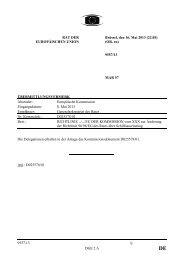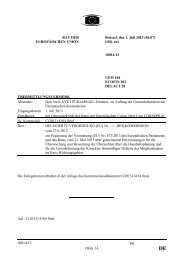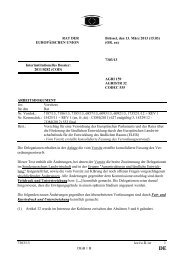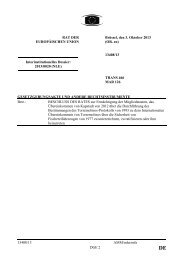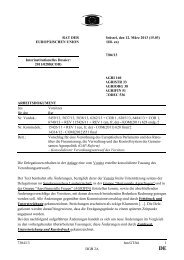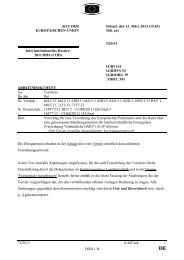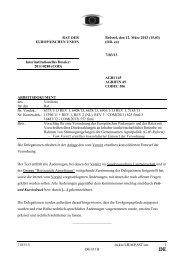17107/12 FL/ne 1 DG E 2 A COU CIL OF THE EUROPEA U ... - Europa
17107/12 FL/ne 1 DG E 2 A COU CIL OF THE EUROPEA U ... - Europa
17107/12 FL/ne 1 DG E 2 A COU CIL OF THE EUROPEA U ... - Europa
Create successful ePaper yourself
Turn your PDF publications into a flip-book with our unique Google optimized e-Paper software.
(8) "be<strong>ne</strong>ficiary" means a Member State, an international organisation, a public or private<br />
undertaking or body that has been selected to receive Union financial aid under this<br />
Regulation and in accordance with the arrangements established in the relevant work<br />
programme referred to in Article 17.<br />
(9) "implementing body" means a public or private undertaking or body designated by a<br />
be<strong>ne</strong>ficiary, where the latter is a Member State or an international organisation, to implement<br />
the action. Such designation shall be decided upon by the be<strong>ne</strong>ficiary under its own<br />
responsibility and, if it requires the award of a procurement contract, in compliance with the<br />
applicable public procurement rules;<br />
(10) "core <strong>ne</strong>twork'" means the transport infrastructure identified according to Chapter III of<br />
Regulation (EU) No XXXX/20<strong>12</strong> [TEN-T Guideli<strong>ne</strong>s];<br />
(11) "core <strong>ne</strong>twork corridors" means an instrument to facilitate the coordinated implementation of<br />
the core <strong>ne</strong>twork as provided for in Chapter IV of Regulation (EU) No XXXX/20<strong>12</strong> [TEN-T<br />
Guideli<strong>ne</strong>s] [and listed in Part I of the An<strong>ne</strong>x to this Regulation];<br />
(<strong>12</strong>) "bottle<strong>ne</strong>ck" in the transport sector means a physical or technical barrier that leads to a system<br />
break affecting the continuity and disruption of transport capacity of long-distance and cross-<br />
border flows. Such a barrier can be absorbed by creating <strong>ne</strong>w or substantially modernising<br />
existing infrastructure in order to increase its capacity such as bridges, locks, groy<strong>ne</strong>s, bottom<br />
sills or tun<strong>ne</strong>ls that address problems as for example gradients, curve radii, gauge, fairway<br />
depth or by upgrading intermediate lower classified sections of infrastructure to the level of<br />
the rest of the <strong>ne</strong>twork;<br />
(13) "priority" means any of the e<strong>ne</strong>rgy infrastructure priorities 1 to 8 and 10 to <strong>12</strong> as designated<br />
in An<strong>ne</strong>x I to Regulation (EU) No XXXX/20<strong>12</strong> [Guideli<strong>ne</strong>s for trans-European e<strong>ne</strong>rgy<br />
infrastructure];<br />
<strong>17107</strong>/<strong>12</strong> <strong>FL</strong>/<strong>ne</strong> 21<br />
ANNEX <strong>DG</strong> E 2 A E




